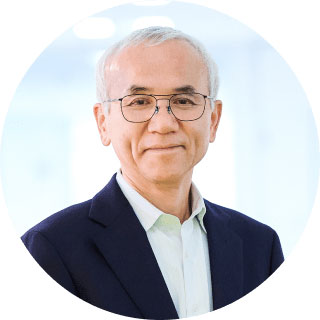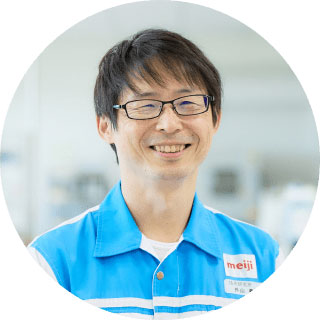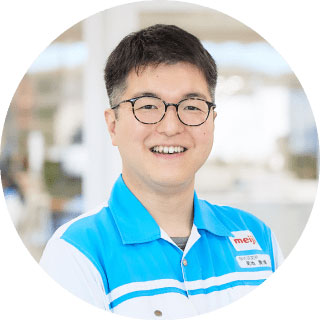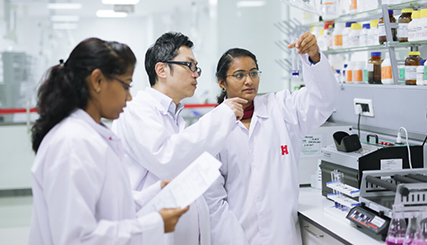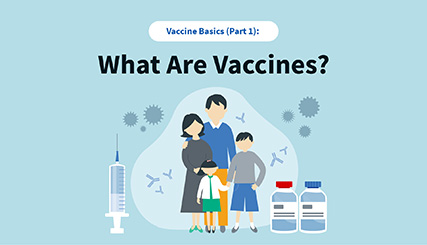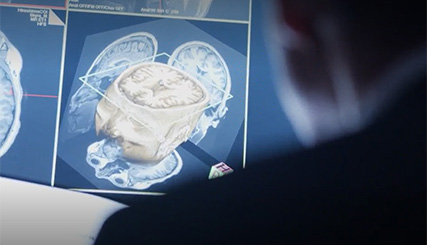In Japan, more than ninety-seven percent of people who die of pneumonia are over sixty-five years old. The main cause of pneumonia is the weakening of one's ability to swallow due to aging.
The importance of revealing the mechanisms involved in human swallowing is key to maintaining a high quality of life. That is why the team at Meiji Group is working with oral surgeon Dr. Michiwaki to develop a swallowing simulator to assist in that goal.
In this roundtable discussion, Dr. Michiwaki shares his support for the Meiji Group's vision along with the latest technological developments.
—Please tell us how the development team was established. We heard that the original theme of your research was similar to this project.
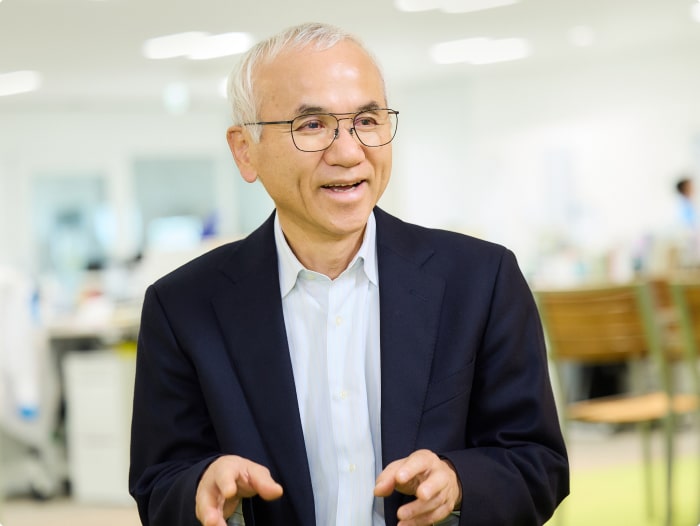
Dr. Michiwaki: That's right. I am a clinician and specialize in the human mouth. My research confirms and patients consistently say that the two most troublesome side effects of mouth-related functional decline are "not being able to speak" and "not being able to eat".
Eating is normally an enjoyable activity, but it can lead to choking or even pneumonia for some people. Sometimes, because of this danger, patients are asked to abstain from ingesting food and obtain nourishment instead via intravenous drips. This is not only unnatural but can also be painful.
Ideally, these patients need a solution that improves their ability to eat safely. For this reason, we wanted to understand in detail how the human body works when ingesting food or liquid.
Kikuchi: My specialty is actually engineering, but I've had a connection with Dr. Michiwaki since I was a university student. I later became a member of his research at the same hospital before joining Meiji.
We envisioned using robots as a possible solution to the issue of ingestion. However, we soon realized robots were not cost-effective, so, with the help of Mr. Toyama, we began joint research to search for other options.
In the long run, I believe that this initiative will lead to the enhancement of the Meiji Group's brand. (Toyama)
Toyama: Eating is an important theme for Meiji Group since we're involved with medical and nursing care products including one that controls the thickness of food. I often attended conferences that featured research on eating, which was where I first saw Dr. Michiwaki present his research. I realized it would greatly improve the quality of life (QOL) for patients, so I voiced my support. Dr. Michwaki responded by saying, "if you support me, let's do it together!" (laughs).
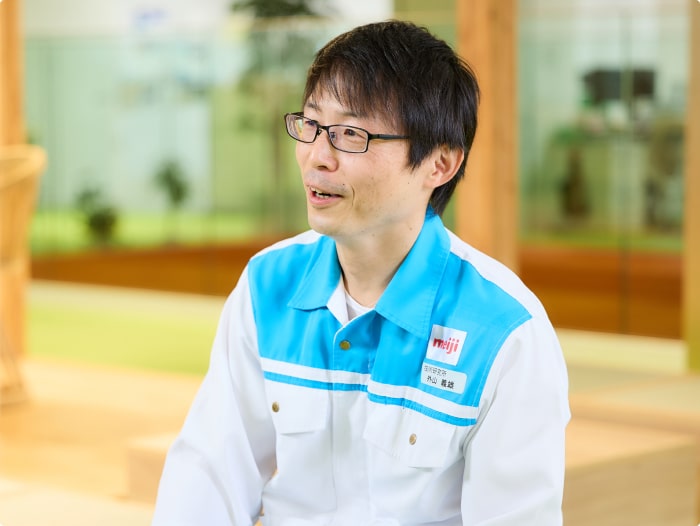
Dr. Michiwaki: It was a memorable moment (laughs). Actually, I had previously considered simulation in joint research with one other university, but I ended up nixing that idea in favor of a different calculation method suggested by Mr. Toyama. The results of the new method proved very promising.
Toyama: Meiji Group does not have clinical data, but we have the technology and know-how to model food. Still, we had to proceed carefully. We knew we were creating something brand new and innovative, but initially, we were a small team led by Dr. Michiwaki, without the security and assurances of large-scale, organizational efforts until the later stages of development.
—What kind of technology is used to simulate swallowing?
Kikuchi: CT scans and other images help create a precise three-dimensional model of the human throat. Then, the physical properties of food are modeled to simulate the mechanisms at work when a person swallows.
Aging or illness sometimes deteriorates the throat's ability to move, making it difficult to swallow properly. We cannot see this condition externally, which makes it impossible to analyze the potential causes with precision. That's why we developed "Swallow Vision" not only as a simulator to see what is happening internally, but also as a tool to help determine the possible causes behind throat deterioration.
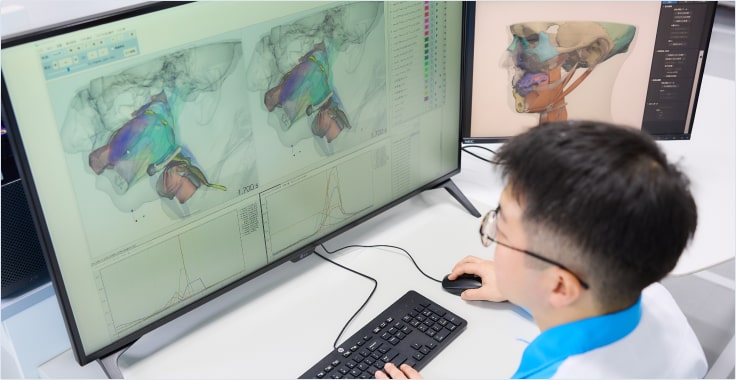
Dr. Michiwaki: Currently, it's a time-consuming process because we are working on a three-dimensional model that simulates each person individually. At this stage, we are not ready to apply this technology to clinical practice, but in the near future, we hope we can automate the creation of a computer-simulated model using hospital CT scans. In so doing, a patient with difficulty swallowing food could go to the hospital and, on the same day, receive countermeasure options based on the simulation's results.
Toyama: Ideally, we could provide helpful suggestions for the patient, including alternative cooking methods that alleviate difficulties when eating or strategies that strengthen specific muscles. This technology can tailor treatments to individual patient needs, which opens the door to a wide variety of precise solutions.
I believe in the long-term potential and social significance of this technology as an enhancement of Meiji Group's brand and as a powerful tool for hospitals, patients, and other fields.
Kikuchi: In fact, we have begun using the simulator to evaluate the safety of products for young children at various development stages. We are also participating in Japan's Consumer Affairs Agency efforts to prevent accidents, such as choking and food aspiration. This further confirms the wide-reaching potential and social significance of the technology when fully utilized.
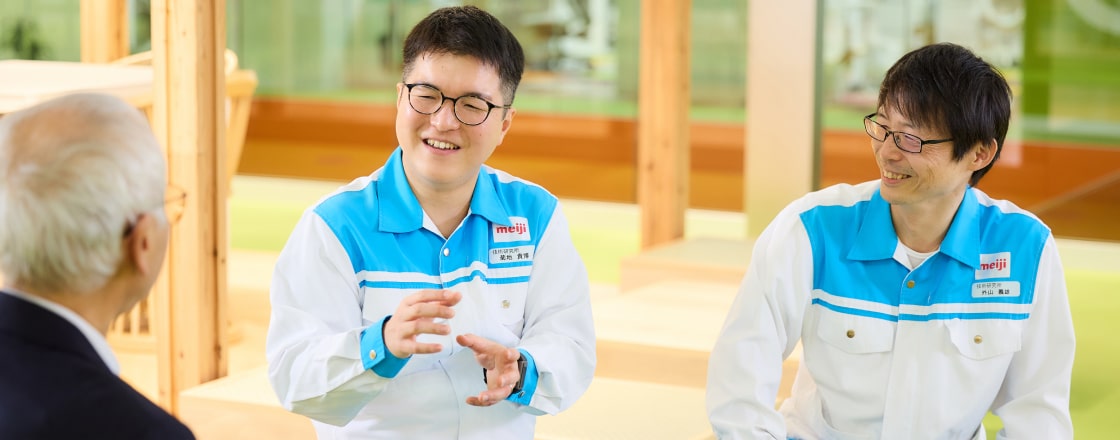
—Are there any difficulties or challenges in the development of the swallowing simulator?
Kikuchi: The biggest challenge is that it takes so much time to create a three-dimensional model from medical imaging such as CT scans. Swallowing is actually a complicated process that occurs at high-speed movements in the body, which makes it difficult to see some objects from imaging alone. Even in areas where movement is visible in the image, the degree of force that causes the movement is invisible. These factors contribute to the difficulty in creating an accurate, verifiable prototype of the 3D model.
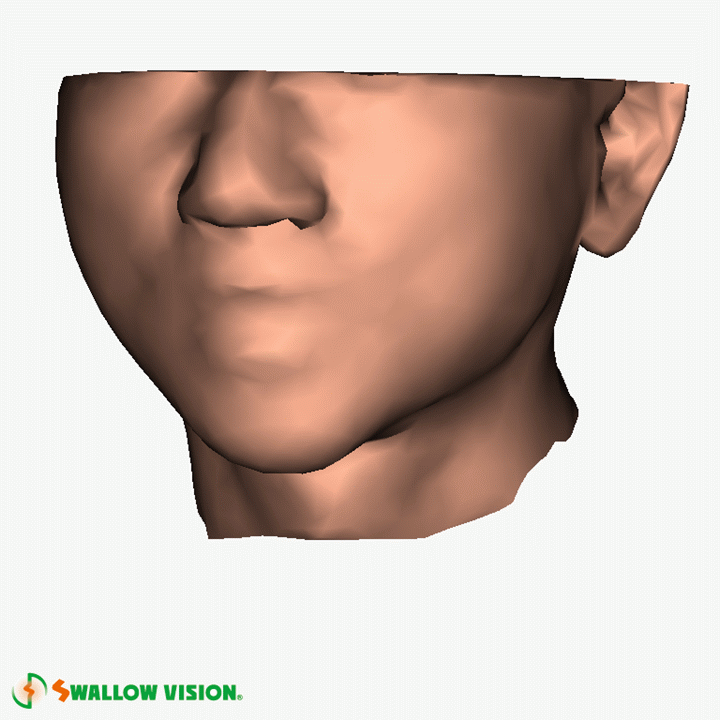
Movement of swallowing water
Kikuchi: For example, the tongue makes the eating process possible by pushing larger pieces of solid food or thicker substances into the throat. Whereas with water or other liquids, there is no such movement of the tongue. X-ray videos can only give us a rough idea of which organs move when, by how much, and how much force the muscles use. A well-founded simulation, however, can track such characteristics of movement and force in more detail. Conversely, if we cannot track these movements with precision, then we cannot understand why someone struggles to swallow.
Dr. Michiwaki: There are two ways to study the human body: through animal testing or clinical trials. It is difficult to use either approach when studying swallowing because animals have different throat structures compared to humans and clinical trials pose safety risks for patients who are at risk when eating. Simulations offer a safe method of obtaining accurate data, similar to crash tests used to obtain automobile safety data. That's why simulation is necessary for our research.

Simulation solves issues in swallowing studies
Investing in a start-up with monitoring swallowing technology
In March 2022, Meiji Holdings invested in PLIMES Corporation, a start-up company developing a monitoring service for ingestion and swallowing. The company's product, "GOKURI" , is a system that acquires swallowing and posture data through a dedicated wearable device.
The system provides simple, objective evaluations of swallowing conditions and, when combined with Meiji Group's swallowing simulation, offers new health value for patients and society.
Meiji invests in PLIMES, a startup developing a monitoring service for ingestion and swallowing
—Please tell us more about the applications and future potential of the simulation technology.
Dr. Michiwaki: The human body functionally declines with age, but we can mitigate that deterioration with proper care and attention. I believe Japan is in a special position to send a positive message about living healthily into the later years since we currently have the world's oldest population.
One way to do that is by fixing medical issues that most often affect the elderly, creating a more comfortable and enjoyable aging experience. For example, elderly people gradually lose the ability to eat and the treatment often prohibits them from eating solid foods. Unfortunately, this further deteriorates function. Instead, it's much better to tailor dietary prescriptions to their individual needs and abilities, allowing them to continue eating.
Swallowing simulation can help accomplish that assessment. By analyzing the throat and programming its movements, we can provide a clearer picture of where the challenges lie for each patient's unique abilities.
I believe Japan is in a special position to send a positive message about living healthily into the later years since we currently have the world's oldest population. (Dr. Michiwaki)
Dr. Michiwaki: Access to on site models of the throat allow us to provide more accurate prescriptions and exercises. We can also simulate what happens after treatment and how patients change as they age.
Dr. Michiwaki: Patients themselves will also have a clearer vision of their recovery process when we share this information.
It can be discouraging for patients to hear "stick out your tongue this many times a day and do these exercises" without knowing the purpose or potential outcomes. It is much more motivating to hear "do these exercises so you can strengthen this part of your body and achieve this result."
Simulation also broadens the range and precision of treatment methods.
For example, moving muscles via exercise also means moving the nerves. However, if the nerves in one part of the body have deteriorated then commands from the brain may be ineffective. In that case, using another nerve as a detour may solve the problem. Exercise is a common treatment plan to accomplish that goal.
The simulation would make this entire process easier by providing a more accurate picture of a muscle's movement, which gives us a better understanding of how nerves connect to the muscle and the pathways of the brain's commands.
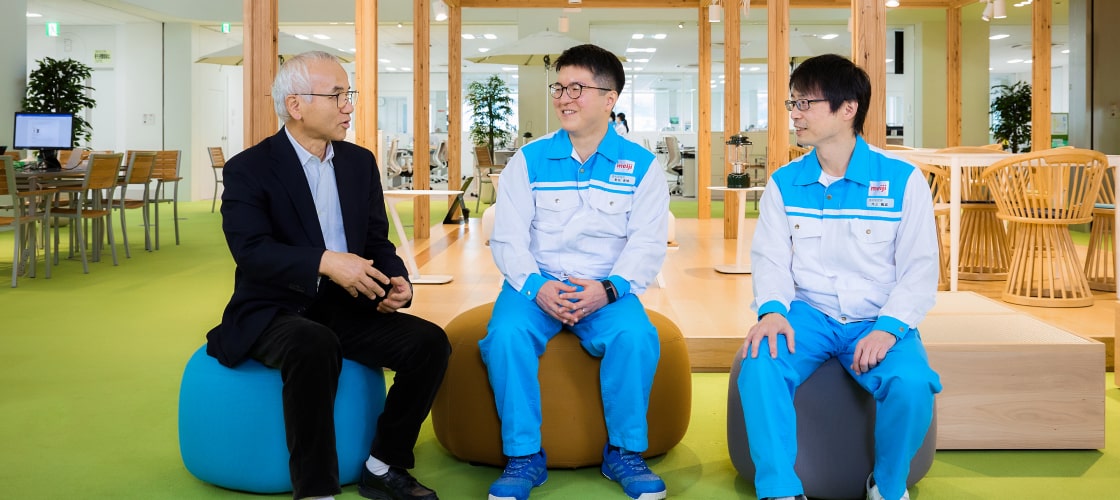
—What challenges do you face in realizing this vision?
Toyama: We are currently working on reducing the time required to create models by automating and streamlining the entire process, but it still takes time. However, expectations are high and the people we meet at academic conferences are often asking about its release date and pricing.
I'm sure people all over the world are conducting similar research, but it doesn't seem to last very long since it takes a lot of time and money to build this level of detail. It's as if the enthusiasm of the members in our group is the main reason why this project continues to this day (laughs).
There is still a lot of work to do. Using the technology in the field requires acquiring the proper rights and legal approvals. We also need to create a set of guidelines that prevent potential misuse of the technology. These factors among others indicate more work ahead, but we're ready to take on the challenge.
Kikuchi: We have already received requests from nursing educational institutions to use the technology in their studies, right?
Toyama: Correct. I know many people and institutions are eager to use the technology and I wish we could make it available immediately. However, we're looking forward to taking on these challenges and solving each problem one by one. That's how we'll make the technology available for practical use as soon as possible.
-We look forward to all the work you're doing. Thank you very much for your time today.
